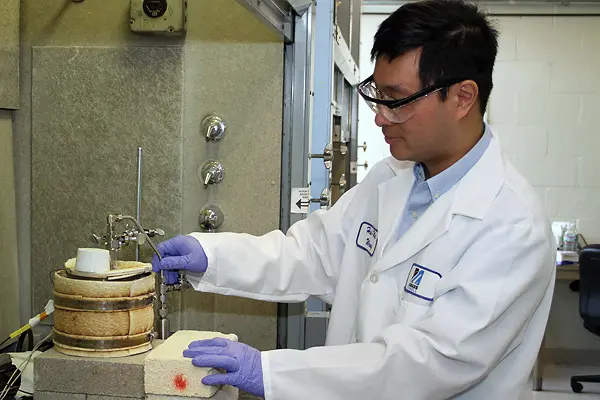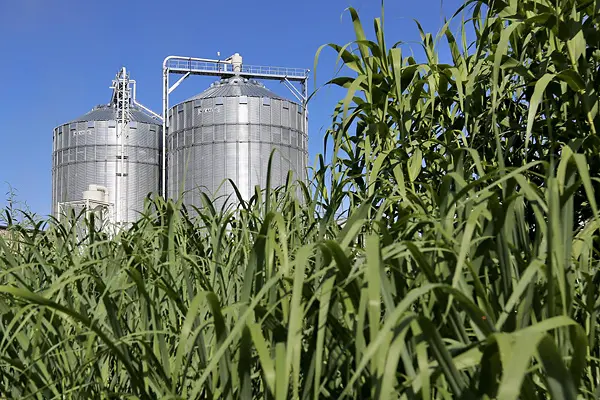Hsi-Wu Wong Receives $500,000 to Support Renewable Energy and Sustainable Chemistry Research
 Image by Edwin L. Aguirre
Image by Edwin L. Aguirre
In Asst. Prof. Hsi-Wu Wong's prototype reactor setup, a sample of biomass-waste mix in a glass tube is heated without oxygen in a furnace to 500 degrees Celsius to pyrolize (break down) the mix into biofuel, which then collects in a steel cylinder.
11/07/2019
By Edwin L. Aguirre
The National Science Foundation (NSF) recently recognized Asst. Prof. Hsi-Wu Wong of the Department of Chemical Engineering with a prestigious faculty early career development grant, called the “CAREER” award. This highly competitive annual program selects the nation’s best young university faculty-scholars “who most effectively integrate research and education within the context of the mission of their organization,” according to the NSF.
Wong, who joined UMass Lowell in 2014, is interested in developing biofuels and bio-based chemicals derived from organic raw materials (biomass) or their waste products. These could supply the world’s energy needs in transportation fuels and consumer products while significantly reducing emission of greenhouse gases into the atmosphere.
Wong will use his NSF award, worth $500,000 spread over five years, to support his research entitled “Molten Polymers for Selective Biomass Fast Pyrolysis to Produce Value-Added Chemicals.”
“My research, although fundamental in nature, will lead to new technologies that utilize sustainable resources to produce biofuels and value-added chemicals instead of traditional fossil-derived resources such as crude oil, coal and natural gas,” says Wong. His study will help facilitate the recycling – or upcycling – of waste biomass and plastics as well as composite waste materials such as plastic-coated papers, waste carpets and floorings.
“My goal is to understand the mechanisms of how plant biomass and plastic waste physically and chemically interact with each other during their co-conversion into biofuels or value-added chemicals,” explains Wong.
Biomass from plants includes corn stover, switchgrass, crop straws and bagasse, scrap wood, sawdust, waste leaves and other nonedible byproducts. Value-added chemicals are those chemical precursors that eventually lead to the production of commodity products and consumer goods such as plastics and textiles. Traditional value-added chemicals derived from petroleum and natural gas include ethylene, benzene, xylene, toluene, butanes and others.
 Image by Oak Ridge National Laboratory
Image by Oak Ridge National Laboratory
According to the U.S. Department of Energy’s Billion Ton Report, published in 2016, the amount of biomass resources from agricultural and forestry waste and algae materials is enough to produce biofuel, biopower and bioproducts to displace approximately 30 percent of the 2005 level of America’s petroleum consumption.
“The potential reduction in greenhouse gas emissions can range from 20 percent to 90 percent, depending on the type of biomass feedstock [raw materials] and the conversion methods used,” says Wong.
Biomass Feedstocks and Molten Polymers
Existing methods used to convert biomass, such as fast pyrolysis, which rapidly decomposes the biomass at high temperature in the absence of oxygen, typically lead to both desired and undesired chemical products.
“The use of catalysts to accelerate desired chemical reaction pathways, or processes, has been widely studied to address this challenge. However, the use of inhibitors to suppress undesired pathways has been rarely explored,” notes Wong.
Molten polymers – thermoplastics from plastic waste that melt at high temperature, yet thermally degrade more slowly than biomass – make good candidates as inhibitors in biomass conversion reactions, says Wong.
In the NSF-funded study, Wong will investigate the use of molten polymers in reaction pathways to selectively increase the yields of the desired products.
“This could potentially transform existing biomass conversion technologies and totally change the landscape of the current chemical industry,” says Wong.
Assisting Wong in the lab work are chemical engineering Ph.D. students Melisa Nallar, Fuat Sakirler and Mihriye Doga Tekbas and undergraduate student Colleen Ahern.
A resident of Burlington, Mass., Wong earned a bachelor’s degree in chemical engineering from National Taiwan University in Taipei and a doctorate from Northwestern University in Evanston, Illinois, and did his postdoctoral research at MIT.
